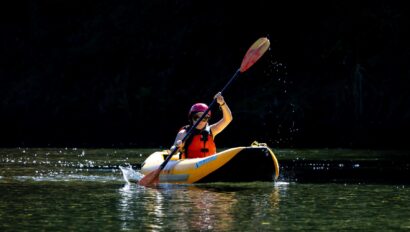What You Need to Know Before Buying a SUP

Ready to buy a stand up paddleboard, but not sure where to begin? This guide to buying a SUP will help focus your search, so you get a board that’s going to match your paddling style and budget, and last for years to come. Here are some key considerations to keep in mind when you start your research…

Where will you paddle?
The first thing to consider when buying a SUP is what type of paddling you’re going to be doing most of the time. Boards are often designed specifically for flat water like lakes, rivers, surfing, or open ocean paddling. Some boards have a more well-rounded shape that allows them to work well in a variety of conditions.
How will you paddle?
Once you’ve thought a bit about where you’ll paddle, it’s time to shift to how you’ll paddle. Are you looking to poke around small lakes on a hot summer day? Are you keen on getting into flatwater racing? Are you paddling mellow, meandering rivers that don’t have any rapids, or are you planning to charge some Class II and III whitewater? Answers to these questions will help you narrow down what type of board design will suit you best.
Inflatable or hard board?
The next thing to consider is whether you want an inflatable or hard board. Each has its pros and cons. Generally, hard boards provide better performance. The rigid construction transfers more energy from each paddle stroke, propelling the board through the water more efficiently. Additionally, depending on the specific design, hard boards are often thinner than inflatable boards, which improves their performance when surfing ocean or river waves.
High-quality inflatable boards perform remarkably well, but they can’t match the flatwater or surfing performance of a hard board. They can, however, be stored and transported easily, making them a great option for folks with limited space, be it at their residence or in their vehicle. Finally, inflatable boards aren’t brittle like hard boards, making them more suitable for downriver and whitewater paddling.
Since 80 percent of my paddling time is on rivers, I use inflatable river-specific boards. When I do head out on a lake, they work well enough. I also live in a small house without a garage, so it’s nice to be able to roll up my boards and store them in my small shed. If I lived on a lake or near some choice ocean swell (and had a garage for storage), I’d probably paddle hard boards.

Longer or shorter?
The size of the board is the next consideration. As a general rule, longer boards track better (i.e. they stay straighter in the water as they’re paddled), and are more efficient, thus faster. However, they don’t turn as well as shorter boards.
Longer boards (generally 10’6”or more) are great for recreational paddlers on lakes and other flatwater. They’ll track well and be fairly efficient. Shorter boards (10’6” or less) are great for folks paddling downriver where efficiency is less important than maneuverability. Most whitewater SUP paddlers consider 9’6” to be the standard, though shorter boards can be better for river surfing and big whitewater that requires a lot of maneuvering. Again, these are general guidelines, not rigid rules. I’ve paddled my 9’8” whitewater board on plenty of lakes, and I’ve paddled my 11’6” flatwater touring board over lots of mellow river miles, including a five-day self-supported trip on the Wild and Scenic Missouri River in Montana.
Paddler size is another consideration. Large paddlers will want a larger board that will support their weight while in the water. Smaller paddlers will want a smaller board that will actually displace water when they’re on it, otherwise, it will be less stable and harder to handle. Boards in the 10-foot range are great all-around boards for most paddlers.
5) Wider or narrower, thick or thin?
Width and thickness are also important. The wider the board, the more stable it will be. Narrower boards are faster and more efficient. Generally displacement hull boards like those for flatwater racing will be longer and narrower – some are more than 14 feet long and as narrow as 25 inches. For comparison, my downriver board is 9’8” long and 36 inches wide.
Heavier paddlers or paddlers looking to carry a lot of gear (or kids, dogs, etc.) may want a thicker board that will support more weight. Lightweight paddlers will be able to control a thinner board more easily and, thus, have more fun. Folks interested in SUP yoga would be better off with a wider board, while those interested in fitness paddling would be wise to consider a narrower board.
6) Rocker or flat?
Hull shape, length, width, and thickness are the primary board-design considerations, but rocker is one final feature to think about. Rocker is more applicable to downriver boards than recreational touring boards, but it’s worth covering. In short, rocker is the amount of curve the board has from tip to tail or bow to stern. Downriver paddlers will be more interested in boards with rocker than flatwater paddlers.

The Small Details
Now that you’ve got a better idea of board shape and design, it’s time to think through some other factors. There are so many board manufacturers out there that sometimes small differences can push your decision one way or another.
- Weight: Some manufacturers highlight that their boards are light. That makes them easier to carry to the water or for the really adventurous, to hike into a secret lake. But it also makes them less stable when subjected to waves, chop, or wind. They’ll get pushed around more than heavier boards. Also, with lighter weight materials, durability can suffer. If you’re easy on gear, don’t have plans to paddle in windy or wavy conditions and don’t want to ask a stranger to help you get your board to the water, a lightweight option might work great. If you’re looking to run whitewater or punch through ocean chop, I’d suggest something that’s a bit heavier.
- The deck pad: The foam pad on top of the board is called the deck pad. A variety of textures and densities are used across brands. Look for one that’s comfortable for you and provides good grip.
- Carry handles and attachment points: Most SUPs will have a carry handle of some sort. This is crucial to allow you to transport the board to and from the water. Make sure the board you choose has a handle that works for you. In addition, boards often have tie-downs or d-rings on the front and back. The placement and number of these are worth considering if you’re planning on bringing cargo.
- Fins: Most boards have at least one removable fin, some have more. Some boards have small fins that are permanently affixed to the board. The way the fins are attached varies as well. Some require a small bolt that you hand tighten; some have a plastic piece that slides in and locks the fin(s) into place. I’m a fan of the simple plastic option since there’s no bolt to lose. But there are more fin designs for the bolt-style fins since they often share the same technology as traditional surfboards. Hala, a board manufacturer out of Colorado, has developed a cool system where the center fin retracts into the body of the board if it hits a rock. Once past the rock, the fin springs back into place.
Cost
Price is a crucial factor for many when considering a SUP purchase. Prices can range from $300 to $2000 (or more!). Well established brands with solid manufacturer warranties will cost a little more while generic boards will be less. Generally rigid fiberglass or carbon fiber boards will be at the higher end of the price scale while inflatables will be lower.
Ready to hit the water? Check out our Beginner’s Guide to Stand up Paddleboarding.
Photos: Tower Paddle Boards/Unsplash & James Kaiser
Related Posts
Sign up for Our Newsletter





